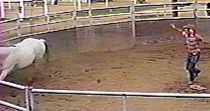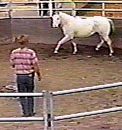Staying "A Kick Away" |
| A SERIOUS PROBLEM |
Revised June 29, 1999
Revised: August 2, 2012
It all started with a kick.
Our Equestrian Safety Program was born when a former boarder who was "playing" with her horse off-lead in another barn's covered arena, took a playful kick in the face as her Arab gelding came running past her. That mishap caused multiple facial fractures to the horse owner and it prompted us to assess how many horse related accidents and fatalities were occurring in the region.
A few stable owners and trainers in the area, along with some interested emergency services personnel, nurses and physicians, got together to discuss the safety problem and determined that equestrian safety needed increased emphasis. The results of this "get together" included the Equestrian Crash Course, the Trailblazer Magazine "Survival Guide" series and independent efforts such as the safety and training presentations provided by the Kickin' Back Ranch on this website.
Kicks are serious business. They can be disfiguring and even fatal. The intent of this feature is not to make you terrified of your horse, but make you aware that nearly all kicks could have been preventable had the handler just been aware, and to make you aware of how to handle your horse safely!
|
Even the small ones can get ya!
This is a 6 month old colt who we were teaching to trailer load for a video sequence. I took my focus off of him while we talked about "setting up a shot." The colt set up his own shot in a playful gesture. 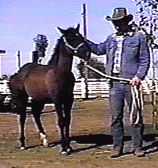
| Hey buddy, got a dime?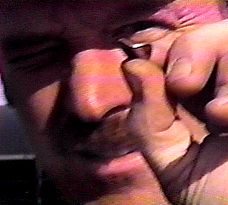
|
Using proper protective gear could have helped mitigate this painful encounter. If I had worn a pair of chinks as I would have done when working a more "aggressive" horse, the leather would have disbursed much of the impact. The lesson here was that safety gear is not just for use when working those really tricky animals! We must add that following the safety project and related helmet study, we don't work horses without wearing proper equestrian helmets any more.
| TYPES OF KICKS |
There are six primary reasons a horse will kick. Understanding what they are will help you assess your situation and take appropriate precautions.
Playful Kicks
The playful kick is also called the "kick that kills." Horses will often play "Tag, you're it" with a nip or the flash of a hoof while running past a playmate. Since horses have good side vision, they usually dodge the kick and chase the mock aggressor or wheel their butts around in response. Humans who do not enjoy lateral monocular vision, as well as inattentive horses, tend to get kicked. Both unwitting horses and humans have been killed this way.Part of the problem stems from the flick of the foot being expressed as a form of attention getting gesture, "Wake up! Let's play!" Thus if you are daydreaming while your horse is playing, you could actually invite such an approach. If you are in an area with playful horses you must stay alert and wave them off if they approach to "buzz" you!
Exuberance Kicks
The exuberant kicker may fire in excitement when first released into a play area (e.g., being turned out for exercise) and accidentally catch the handler who just released him. A horse which has never displayed this behavior might do so when turned out with other horses or when something is present which that gets his attention and excites him. We always back potentially exuberant horses down the lead rope a couple of times, get their attention, have them face us when we unhalter them, then hold them in place with the lead rope around their neck until we take a couple of steps back.Fearful Kicks
A fearful kicker is akin to a fear-biting dog. He feels threatened and trapped and is doing nothing more than what he feels he has to do to protect himself.Freshly captured feral horses and previously abused horses can offer the handler a fear kick if they are not handled correctly. These horses will appear tense, their tails clamped against their buttocks, heads high, eyes wide open and sometimes nostrils flared. In such circumstances the handler should be careful not to pressure the horse into a flight or fight decision, especially if the horse is cornered or secured and cannot flee.
If I see a frightened horse "loading up," I will yield him some space. I'm not relinquishing my authority and position by doing this if I time the move correctly. The conversation which is taking place is the horse telling me, "Human, I can't take much more of this!"
In such an instance my appropriate response would be to step back one or two steps to say, "OK, horse, I'll give you a little space with which to get a grip on your emotions." What I don't want to do is to push the horse to the point he has to cock a hind leg and threaten to fire at me. If I wait that long to yield, he could develop an association between his aggressive behavior and my getting out of his way. Once he discovers this "tool," he'll be really difficult to work with and this will no longer be a problem suitable for a novice to deal with.
An effective alternative to triggering a showdown is to let the horse leave and in a controlled environment, put him to work in a safe endeavor such as longeing in a circle. He needs to work off his stress and get his emotions under control before you can do much with him and longeing gives you an alternative where you can get yourself out of a tough spot but still remain the leader. You don't necessarily need to work the horse hard. Oftentimes just letting him walk and clear his head can reset the encounter.
Disrespectful Kicks
|
The disrespectful kicker is basically saying "up yours." He'll cock his rear end toward you and flash you the bottom of his hoof. Disrespect seldom involves actual contact, however you can be accidentally struck and unchecked disrespect can lead to more aggressive behavior as the horse starts to believe he is the more dominant of the two of you. As you can see from the second frame in the sequence, the horse is watching me and is well clear of me before firing, however he can get quite a bit of extension with that hind leg. I certainly don't want to be closing distance on him at this point! |
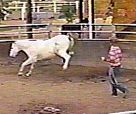
|

|
|
We handle disrespectful kickers with an immediate assertive
response. The disrespectful horse typically fires and runs and we'll drive him forward from a safe distance making it clear in no uncertain terms that we are displeased with his display and we can make him work. If on a longe line or in a round corral, we will quickly send him out and make him yield his hind quarters several times (as an offended dominant horse would to the offender), but at the same time anticipate his asking forgiveness by his looking in towards us with a more submissive posture and expression.
At the instant the horse displays submissive body language we would become immediately relaxed, let him come in and positively reinforce his decision to behave himself just as we "negatively reinforced" his infraction. If the horse makes a mistake that we correct, we have to clearly indicate to him that we recognize when he "gets right." |
|
Aggressive Kicks
An aggressive kicker can be particularly dangerous, although more predictable than a playful kicker. The aggressive kicker is likely to confront you "rump-on / head on." By this I mean he's not likely to engage in a sneak attack. He's likely to wheel his butt around and come straight at you. If you suspect a horse is aggressive you need protective equipment and you have to know what you are doing.When I confront an aggressive kicker I make sure I'm wearing a helmet and have a proper 12 ft. or 15 ft. horse handling rope and the layout includes somewhere for me to send the horse. As soon as he starts to load up to kick me, I'll go after him aggressively twirling the rope at his hindquarters. I have to make him question the effectiveness of his aggression and decide to leave. I will not, however, pursue him.
Committed aggressors will often come after me a couple of times more to see if the unexpected response was temporary and if they can intimidate me. I have to not only hold my ground, but take away some of their territory each time they try me out. I will not try to prolong the tension and I will always give the horse a clear escape route.
If I am fortunate enough to encounter the horse in a round corral or small arena, I will send him off on longe as best I can. As soon as the horse has had a chance to blow off his anxiety, I will cause him to yield several times. The instant he shows me that he is willing to be submissive, I will back off and let him rest. Unlike the disrespectful horse whom I will encourage to come in right away and be buddies when he shows me good behavior, I'm going to keep the aggressive horse at a respectful distance for a few outings until he can demonstrate to me that he can keep his aggressive tendencies in check. Only at that pointwill I extend some trust and attempt to make friends.
Nuisance Kickers
Incidental accidents occur with nuisance kickers. These horses cow kick when they are irritated, typically by flies, but they can also cow kick when they are irritated by the handler's touch. Cow kicks don't sound dangerous, but they can take the form of sharp blows. Although many are little more than very uncomfortable "brush-offs," some have resulted in unplanned trips to the Emergency Room.Horses that are poorly groomed, fly infested or have dirty teats or sheaths may be uncomfortable and kick at their underbellies. When we see a horse displaying this type of behavior, we try to resolve the nuisance which is prompting the cow kicks, bearing in mind that the horse is likely to bring a leg forward as we work on him.
Horses similarly can kick backwards at nuisances which could be nothing more than irritating sweat running down their legs. Again, observing the horse for a short while before handling him may reveal the presence of these irritating nuisances.
To be safe, before we handle a nuisance kicker we will attempt to keep the horse standing square. If he is overly fidgety, someone can hold his near side front leg up so that the horse can't cow kick on that same side. (Please note that some horses can cow kick on the opposite diagonal, so you need to be standing on the same side as the lifted foreleg.) If the horse insists on putting his front leg down, you should stay clear of the "kicking arc" when working near his belly or rib cage.
General Notes:
Don't surprise the horse. Let him know where you are at all times. Stay alert to unusual movements or weight shifts. Don't let yourself get placed between the hind end of any unproven horse and a solid object such as a wall or fence.Little kids can easily disappear into a horse's blind spot, then pop into view when they make some sudden movement, startling the horse. Children have been seriously hurt by horses who have never kicked before when they have been playing in or have run up into the horse's blind spot.
When grooming around the horse's hind end, stay close to the horse on either side. It's safer to be shoved than smacked. If you sense the horse is going to kick, you can push away from the horse and at the same time move him away from you. Don't linger directly behind the horse "in the gun barrel." When picking up feet, notice the "arc path" of the foot and make sure you don't put your leg or feet in line for a kick or stomp if the horse takes his foot back.
With unproven horses, pay attention not only to the horse but to things going on around you. Don't get uptight about these things yourself as that may serve to unnerve the horse, but be aware. If external things start to happen that you can't control and that appear to upset the horse, back off until things subside and you can make a safe approach.
| REAL LIFE TRAGEDY |
I would just like to thank you for your input on horse kicking injuries. I wish there was more info out there for the equine riders and handlers. I am speaking from a tragic and near fatal experience which happened May 98.
Our 13yr old daughter was exhibiting in a local show and awaiting a showmanship class when the horse in front of her suddenly kicked out striking her in the left side of her skull shattering it literally into thousands of pieces. Our world as we knew it ended that second when we witnessed the accident. Our daughter was life-flighted 45 miles away to the nearest trauma center where she was listed gravelly critical with a traumatic brain injury (TBI). She underwent 3 separate emergency brain
surgeries to repair the damage including removal of the left frontal lobe of her brain as it was completely destroyed. This of course caused paralysis to her right side.
For a child who was not expected to pull thru this tragic accident we are very fortunate and blessed to have her with us today. Although she will never be 100% and continues with her rehabilitation daily and will continue this way for the rest of her life let this be a lesson to others through our tragedy that horses are very powerful animals and can cause very serious injury and death. I have seen too many handlers not paying attention to the behavior of their horse or the others around them. When a horse is upset or bothered they will let you know
with their body language whether it be pinning their ears back, or swishing their tail, they are warning that something is about to happen. You need to pay attention at all times and should always wear a helmet even if you are only doing ground work.
PAY ATTENTION AND BE ALERT TO HORSE BEHAVIOR!
|
INCREASING EQUESTRIAN SAFETY IN YOUR REGION |
The results will be an incredible amount of knowledge and experience collected in one place at one time which otherwise is almost impossible to access nowadays unless you were willing to pay a lot of money! If the workshop involves "real people" and "real horses," it should be most interesting and well worth your horsey friends' attendance.
A good program starts with an overview of the problem and a progression of presentations in a sequence such as basic horse handling, prevention and problem solving, emergency first aid, how the local 9-1-1 and/or emergency services operate, which would then lead to a discussion by trauma center employees and physicians as to what they see when trauma victims arrive there. We even inserted in our program a feature presented by a veterinarian on how to safely handle injured horses.
The really cool part is that once these professionals were motivated, they not only participated and presented their "modules" for free, but they found others in their professional peer groups to also participate and share their expertise.
Just food for thought...
Email the author
Return to Safety Main Page
Return to Training Section
Go To  KBR Horse Net
KBR Horse Net
KBR Horse Safety Information, © 1996
Lamm's Kickin' Back Ranch and Willis & Sharon Lamm. All rights reserved. Duplication of any of
this material for commercial use is prohibited without express written permission.
This prohibition is not intended to extend to personal non-commercial use, including sharing
with others for safety and learning purposes, provided this copyright notice is
attached.
Email us to submit comments or
request reproduction permission.
